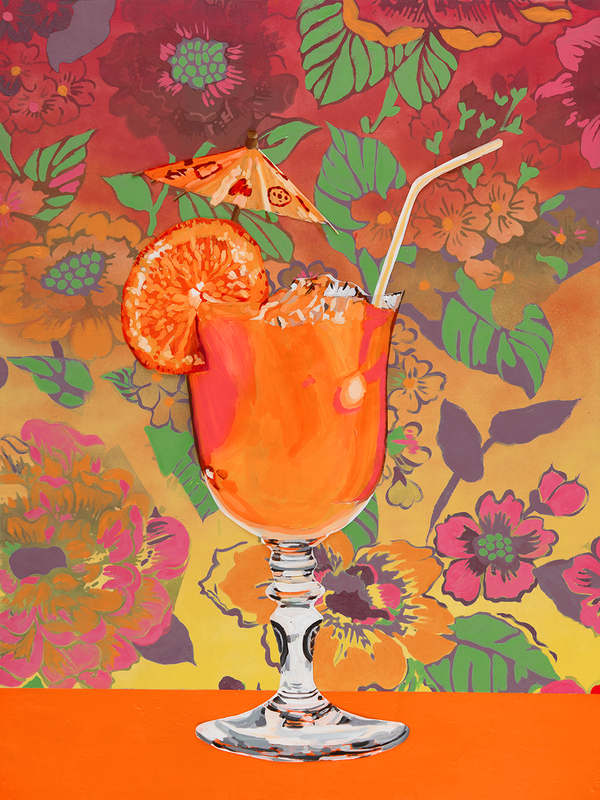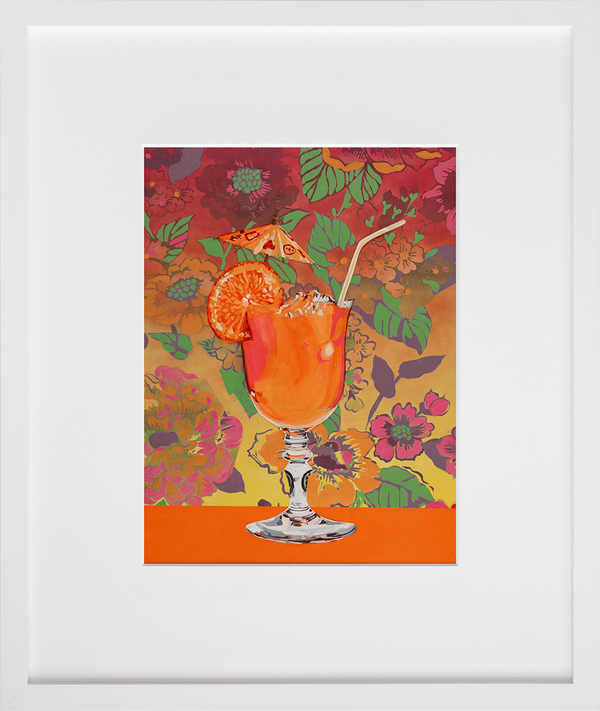
I still remember my first Wegman video. I was three, maybe four years old, giggling and pointing at the television as I watched three dogs with human bodies reenact the nursery rhyme "Rub-a-dub-dub". Who knew that twenty years later, I'd meet the man behind the dogs?
Bill is an important part of the 20x200 family. He is an incredible artist across several different mediums (painting, photography and video), and he's one of our favorite artists to visit because everyone who lives and works there is so gosh-darn nice. But he is also an artist who truly believes in what we are all about: getting great art out to the people. We're so thrilled to be able to give you this look at his stunning studio!
- Carly & 20x200
[powr-image-slider label="WegmanStudio"]
Studio Speak
Where's your studio?
We're here in New York, in Chelsea. Our studio is a great space for dogs because there's outdoor space. I have separate zones for painting and photography, for having lunch, for sleeping, for meeting with people and my friends.
What's your favorite "tool" in the studio?
I'm a painter. The camera is the thing I'm least comfortable with - I had a student of mine teach me how to print and develop and use a camera when I was teaching art at the University of Wisconsin. That was the first time I ever picked up a camera, I never did as a kid. I was always a painter. I did get involved in early video, which I also really - pardon me, but I did really good pieces of video, but I hated using it because I'm very inept mechanically. But painting with a brush or drawing with a pencil, I'm pretty comfortable with. As I say, painting is my underdog.
What do you wear when working in the studio?
The same thing I wear wherever I go! And in the winter, that's a v-neck sweater and jeans, and in the summer a t-shirt and jeans. Or shorts. And some of them are pretty unattractive, as I've seen from documentaries on me in the past. The documentaries are usually done outside in Maine in the summer, and the collection of shorts I've worn over the years is…pretty terrifying.
What's on your in-studio playlist?
I'm a classical music fanatic. When I paint, I usually listen to 20th century or 21st century classical music. Lately it's been Spectralism. I got very involved in the viola da gamba from the Renaissance period when I lived in the East Village, because it masked the sound from the Pyramid Club, which would pump bass into my area. So I got interested in the cello and viola. But I listen to a lot of lute music at night. I feel like the French king, I go to sleep like Louis XIV, listening to my favorite lutenists. And then during the day, out here, when my wife is around, we'll listen to Bach, Brahms, Beethoven - that kind of classical music.
I got really connected when I was in art school in Boston; they had really great radio stations for classical music. They had lots of concerts you could go to. Then when I was in grad school at Illinois, I befriended the composers there and in the sixties, I worked with computer scientists and composers in interactive environments, and so forth. So that's my background - much more interested in music than I am in anything else! Except hockey, which is another one of my obsessions.
What's your favorite way to sweat it out?
I play hockey, I'm on many teams. One of my teams gave me this jersey when I turned 70 last year - Wegman Warriors, number 70 - it's pretty amazing. My son is a phenomenal player. We still skate together, we have a couple of teams we're on together. It's great we get to share that. Before I got back into hockey, I was playing tennis, working out, taking long bike rides with the dogs in Maine. When I was a kid, I used to play all of the sports - except basketball, because I'm not tall. Or fast. But I played baseball and things like that.
When you're older, somehow, running is difficult but gliding across ice isn't. And it's just really cool to score a goal, or make a nice play, or even have your body at that angle when you're as old as I am. It's fun.
What's the first thing you do when you arrive in the studio?
Well, it depends which studio. If it's the photo studio, it's collect props and things that I might be working with. It's a way of almost meditating on what I might be doing. I used to make little sketches of what I might be taking pictures of, but I don't anymore - I kind of trust the moment, and my instincts, and then I feel free to veer off and get something different. Unless I'm doing a book and I have to get an ending for Cinderella or something like that, then I don't bother scripting things, I just have a general idea.
And with painting, I've been working with these postcards, which I attach. So I collate those things and see which cards I might be using. I'm fanatical about cleaning my brushes and taking care of those things, so after I paint I'm very tidy. While I'm painting…I'm kind of all over the place!
What's your favorite way to procrastinate in the studio?
When I'm downstairs in the photo studio and working with the dogs, and say, fabric, or props, I fuss with them forever, and for no apparent reason, flipping things this way or that way or this way. It's really just procrastinating.
Which artists' 20x200 collections do you most covet?
I'm not as much into visual art as I am into music. I think a lot of people, if they're involved in something, aren't necessarily interested in collecting their own medium.

Bill uses many different tools to create his paintings - seen here, two palettes, a T-square, postcards, and a hand sander!
Whens, Hows & Whys
When did you first realize you wanted to become an artist?
I was always an artist. I veered off in high school until I needed an A so I took art. And then my art teacher said I should go to art school, so I did! I was always drawing pictures as a little boy. I loved to stay home from school and do watercolors with my mother. I almost didn't go to art school because they didn't have a hockey team, and I really loved hockey but I decided to go anyway, and thank god, because I never would've made it in hockey.
How’d you get there? What's the story behind the dogs?
I never thought I would get a dog as an adult. I had one growing up, but not to make works with. But I just had started video and photo, so I had those materials at my studio, and suddenly I had a very young puppy - six weeks old - who I had to take care of. He got into everything, except when I was photographing him - he got very still and interested…and interesting. I think it was really that I was involved with photo and video and then got the dog, Man Ray, almost at the same time. The pieces I would show with the dog were very rare, like maybe 1 in 20 or 1 in 10, it wasn't every one like it is now.
After five years, I got Fay Ray. I didn't work with her right away because I didn't want to repeat that. But then I did, and saw that it was good. And then Fay had puppies, and that added a whole new cast, which led to the children's books and to other, more narrative pieces, as well as abstract combinations with lots of dogs.
How do you get over creative blocks?
I don't think I have them. I've had bad periods, but I haven't realized it when I was in the middle of it, it's always in retrospect that I look and say, "God, those are awful, why did I do that?" I rarely have creative blocks. I don't really have to do anything and I don't have just one thing that I do, so I can just bounce around. I'm comfortable letting some works sit for months at a time until I figure out what I want to do.
I think artists need limitations, they need to know what they can't do and what they shouldn't do. I remember when I was a young artist, it was, "I don't do this, I don't do this, I'm only this, I'm not that." And that helps define you. And once you have that definition, then it becomes the problem of breaking out of a too-strict mold. But I'm really comfortable, I've had enough recognition where I don't care as much about it. Although I still like it when I get a good review, and don't like it when I get a bad one, it's not make-or-break.
What do you like best about 20x200?
I love having my work get out to more people than could walk into a gallery and afford something. It's always been a wish of mine that more people could have my work. I remember talking to my first art dealer in New York about my drawings and I said, "These should only be, like, 50 dollars," and she said, "No one would buy them for that, they have to be a thousand, otherwise they don't think it's worth anything." I was so prolific then that I didn't think it mattered, I just thought everyone should have them, and now this sort of solves that.

Several of Bill's postcard paintings - he views the series as an "expand beyond the edge" of the postcard, pushing his own imagination

Dogs keep an eye on everything in the studio, from Polaroid negatives to suitcases of postcards from collectors!
P.S. In Case You Missed It...
Check out our recent amazing release, "Letters", by William Wegman, composed of 26 different editions from the famous ABC video!
The 411 on William Wegman
A pioneer video artist, conceptualist, photographer, painter and writer, William Wegman moves fluidly among various media: from conceptual works to commissioned magazine shots; videos shown in museums to television segments made for Sesame Street and Saturday Night Live; artists' books portraying 19th-century naturalist studies to children's books revealing tongue-in-cheek portraits of town and country life; and from photographic "landscapes" employing his Weimaraner muses to his most recent cycle of landscapes combining found scenic souvenir postcards with drawing, collage and painting. Several of his pieces - photographs, paintings, and drawings - are available as 20x200 editions!
Professional Site: William Wegman Blog: Wegman World Children's Site: Wegman World Twitter: @williamwegman












